
Eremophila oldfieldii, commonly known as pixie bush, is a flowering plant in the figwort family, Scrophulariaceae and is endemic to Western Australia. It is a shrub or small tree with rough bark, broad, flat or narrow fleshy leaves and red, orange or yellow flowers.

Gastrolobium melanopetalum is a shrub in the family Fabaceae which is endemic to the south-west of Western Australia.
Chthonocephalus tomentellus is an annual herb in the family Asteraceae. It is endemic to Western Australia, occurring in saline depressions. Yellow flowers are produced between August and November in its native range. The species was first formally described as Lachnothalamus tomentellus by botanist Ferdinand von Mueller in 1863 in Fragmenta Phytographiae Australiae from a type specimen collected near the mouth of the Murchison River.
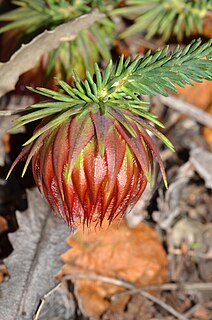
Darwinia neildiana, commonly known as fringed bell, is a shrub which is endemic to Western Australia. It grows to between 0.2 and 1 metre in height and produces red flowers between August and December in the species' native range. The species was first formally described by Victorian Government botanist Ferdinand von Mueller in 1875 in Fragmenta Phytographiae Australiae. It grows among rocks in the Avon Wheatbelt, Geraldton Sandplains and Swan Coastal Plain biogeographic regions of south-western Western Australia.

Grevillea stenomera, commonly known as lace net grevillea, is a shrub in the family Proteaceae. It is endemic to the Gascoyne and north western parts of the Mid West regions of Western Australia, occurring between Kalbarri and Tamala.

Adenanthos detmoldii, commonly known as Scott River jugflower or yellow jugflower, is a species of shrub in the family Proteaceae. It is endemic to the south-west of Western Australia.
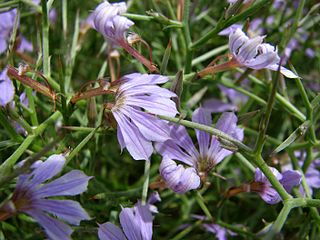
Scaevola oxyclona, commonly known as tangled fanflower, is a spiny shrub in the family Goodeniaceae, native to Western Australia. It grows to between 0.1 and 1.5 metres high and produces blue to purple flowers from August to December in its native range. The species was first formally described in 1876 by Victorian Government Botanist Ferdinand von Mueller in the tenth volume of Fragmenta Phytographiae Australiae based on plant material collected at Frasers Range and Mount Benjamin.

Olearia homolepis is a species of flowering plant in the family Asteraceae and is endemic to Western Australia. It is a shrub with linear leaves and white or blue and yellow, daisy-like inflorescences.

Grevillea commutata is a species of flowering plant in the family Proteaceae and is endemic to the west of Western Australia. It is a spreading, open to dense shrub with egg-shaped leaves with the narrower end towards the base, and white, cream-coloured, and pinkish-green flowers.
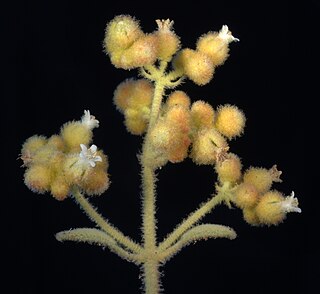
Dicrastylis exsuccosa is a species of plant within the genus, Dicrastylis, in the family Lamiaceae. It is endemic to inland Australia and found in Western Australia, the Northern Territory and South Australia.

Isopogon tridens, commonly known as the three-toothed coneflower, is a species of flowering plant in the family Proteaceae and is endemic to the southwest of Western Australia. It is a shrub with wedge-shaped leaves with two or three sharply-pointed teeth, and flattened-spherical heads of glabrous creamy white, sometimes purple flowers.

Leucopogon plumuliflorus is a shrub in the family Ericaceae. It is endemic to Western Australia.
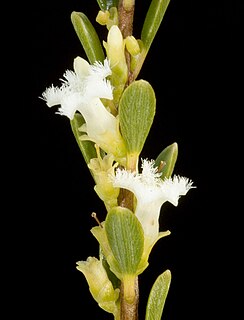
Styphelia crassifolia is a plant in the family Ericaceae native to Western Australia. It was first described in 1845 as Leucopogon crassifolius by Otto Wilhelm Sonder. In 1867 Ferdinand von Mueller transferred it to the genus, Styphelia, but the accepted name continued to be Leucopogon crassifolius. However, in 2020, with a publication concerning the phylogeny of Styphelia by Crayn and others, the name Styphelia crassifolia was accepted by the Herbarium of Western Australia.
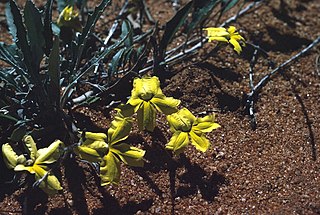
Goodenia xanthosperma, commonly known as yellow-seeded goodenia, is a species of flowering plant in the family Goodeniaceae and is endemic to southern inland Western Australia. It is a prostrate herb with elliptic to egg-shaped leaves at the base of the plant and racemes of yellow flowers with purplish markings.

Kennedia beckxiana, commonly known as Cape Arid kennedia, is a species of flowering plant in the family Fabaceae and is endemic to the south-west of Western Australia. It is a prostrate or twining shrub or a climber with trifoliate leaves and red and yellow, pea-like flowers.

Hybanthus floribundus is a plant in the Violaceae family, found in southern Western Australia, southern South Australia, Victoria and southern New South Wales.
Lechenaultia chlorantha, commonly known as Kalbarri leschenaultia, is a species of flowering plant in the family Goodeniaceae and is endemic to a restricted area near Kalbarri in Western Australia. It is a subshrub or shrub with many branches, crowded, narrow, fleshy leaves and pale bluish-green, tube-shaped flowers.

Lechenaultia longiloba, commonly named Irwin leschenaultia, is a species of flowering plant in the family Goodeniaceae and is endemic to the south-west of Western Australia. It is a straggling, low-lying herb or subshrub with narrow, rather fleshy leaves, and pale yellow or green petals with deep pink or red wings.
Lechenaultia striata is a species of flowering plant in the family Goodeniaceae and is endemic to arid inland areas of Australia. It is an ascending herb or subshrub with only a few wand-like branches, crowded, narrow fleshy leaves and pale blue to pale yellow or creamy-white flowers.
Olearia cassiniae is a species of flowering plant in the family Asteraceae and is endemic to the south-west of Western Australia. It is an erect or spreading shrub that typically grows to a height of 0.7–1.8 m and produces white daisy-like inflorescences, mostly between February and April. The species was first formally described in 1865 by Ferdinand von Mueller who gave it the name Aster cassiniae in Fragmenta Phytographiae Australiae from specimens collected by George Maxwell. In 1867, George Bentham changed the name to Olearia cassiniae in Flora Australiensis. The specific epithet (cassiniae) is a reference to the genus Cassinia.
















